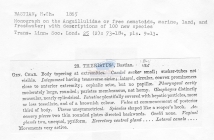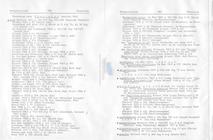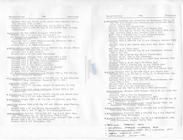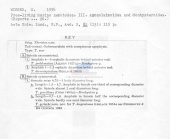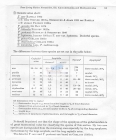
|
World Database of NematodesLinked to the Marine Biology Section, UGent |
| Start | Browse taxonomy |
Search taxonomy |
Search literature |
Search distributions |
Identification keys |
Media gallery | Editors | Statistics | Citations | Match taxa | Contact | Login |
NARMS taxon detailsTheristus Bastian, 1865
2469 (urn:lsid:marinespecies.org:taxname:2469)
accepted
Genus
Theristus (Penzancia) de Man, 1889 · unaccepted
marine, brackish, fresh, terrestrial
Bastian, H. C. (1865). Monograph of the Anguillulidae, or Free Nematoids, Marine, Land, and Freshwater; with Descriptions of 100 New Species. The Transactions of the Linnean Society of London. Volume XXV. Part II:73-184.
page(s): 156-157, pl: XIII, fig: 187-189 [details]
Nemys eds. (2024). Nemys: World Database of Nematodes. Theristus Bastian, 1865. Accessed through: Costello, M.J.; Bouchet, P.; Boxshall, G.; Arvanitidis, C.; Appeltans, W. (2024) European Register of Marine Species at: http://www.marbef.org/data/aphia.php?p=taxdetails&id=2469 on 2025-04-06
Costello, M.J.; Bouchet, P.; Boxshall, G.; Arvanitidis, C.; Appeltans, W. (2025). European Register of Marine Species. Theristus Bastian, 1865. Accessed at: https://www.vliz.be/vmdcdata/narms/narms.php?p=taxdetails&id=2469 on 2025-04-06
Date action by 2004-12-21 15:54:05Z created db_admin
original description
Bastian, H. C. (1865). Monograph of the Anguillulidae, or Free Nematoids, Marine, Land, and Freshwater; with Descriptions of 100 New Species. The Transactions of the Linnean Society of London. Volume XXV. Part II:73-184.
page(s): 156-157, pl: XIII, fig: 187-189 [details] taxonomy source Venekey, V.; Gheller, P. F.; Maria, T. F.; Brustolin, M. C.; Kandratavicius, N.; Vieira, D. C.; Brito, S.; Souza, G. S.; Fonseca, G. (2014). The state of the art of Xyalidae (Nematoda, Monhysterida) with reference to the Brazilian records. Marine Biodiversity. 44(3): 367-390., available online at https://doi.org/10.1007/s12526-014-0226-3 [details] Available for editors basis of record Nemaslan: Biodiversity of Antarctic Nematodes (2004). (look up in IMIS) [details] additional source Brunel, P., L. Bosse & G. Lamarche. (1998). Catalogue of the marine invertebrates of the estuary and Gulf of St. Lawrence. Canadian Special Publication of Fisheries and Aquatic Sciences, 126. 405 pp. (look up in IMIS) [details] Available for editors additional source Li, J.; Vincx, M. (1993). The temporal variation of intertidal nematodes in the Westerschelde. I. The importance of an estuarine gradient. Netherlands Journal of Aquatic Ecology. 27 (2-4): 319-326. (look up in IMIS) [details] Available for editors additional source Lorenzen, S. (1977). Revision der Xyalidae (freilebende Nematoden) auf der Grundlage einer kritischen Analyse von 56 Arten aus Nord- und Ostsee. Veroff. Inst. Meeresforsch. Bremerh. 16: 197-261. (look up in IMIS) [details] Available for editors additional source Maria, T. F.; Esteves, A. M.; Smol, N.; Vanreusel, A.; Decraemer, W. (2008). Nematodes from sandy beaches of Guanabara Bay, Rio de Janeiro, Brazil. Bioci�ncias, Porto Alegre. 16 (2), 92-103. [details] Available for editors additional source Miljutin, D. M.; Gad, G.; Miljutina, M. M.; Mokievsky, V. O.; Fonseca-Genevois, V.; Esteves, A. M. (2010). The state of knowledge on deep-sea nematode taxonomy: how many valid species are known down there?. Marine Biodiversity. 40(3): 143-159., available online at https://doi.org/10.1007/s12526-010-0041-4 [details] Available for editors additional source Sebastian, S.; Raes, M.; De Mesel, I.; Vanreusel, A. (2007). Comparison of the nematode fauna from the Weddell Sea Abyssal Plain with two North Atlantic abyssal sites. Deep Sea Research Part II: Topical Studies in Oceanography. 54(16-17): 1727-1736. (look up in IMIS), available online at https://doi.org/10.1016/j.dsr2.2007.07.004 [details] Available for editors additional source Van Gaever, S.; Gal�ron, J.; Sibuet, M.; Vanreusel, A. (2009). Deep-sea habitat heterogeneity influence on meiofaunal communities in the Gulf of Guinea. Deep Sea Research Part II: Topical Studies in Oceanography. 56(23): 2259-2269., available online at https://doi.org/10.1016/j.dsr2.2009.04.008 [details] Available for editors additional source Van Gaever, S.; Moodley, L.; De Beer, D.; Vanreusel, A. (2006). Meiobenthos at the Arctic H�kon Mosby Mud Volcano, with a parental-caring nematode thriving in sulphide-rich sediments. Marine Ecology Progress Series. 321: 143-155., available online at https://doi.org/10.3354/meps321143 [details] Available for editors additional source Van Gaever, S.; Olu, K.; Derycke, S.; Vanreusel, A. (2009). Metazoan meiofaunal communities at cold seeps along the Norwegian margin: Influence of habitat heterogeneity and evidence for connection with shallow-water habitats. Deep Sea Research Part I: Oceanographic Research Papers. 56(5): 772-785., available online at https://doi.org/10.1016/j.dsr.2008.12.015 [details] Available for editors additional source Vanreusel, A.; Fonseca, G.; Danovaro, R.; Da Silva, M. C.; Esteves, A. M.; Ferrero, T.; Gad, G.; Galtsova, V.; Gambi, C.; Da Fons�ca Genevois, V.; Ingels, J.; Ingole, B.; Lampadariou, N.; Merckx, B.; Miljutin, D.; Miljutina, M.; Muthumbi, A.; Netto, S.; Portnova, D.; Radziejewska, T.; Raes, M.; Tchesunov, A.; Vanaverbeke, J.; Van Gaever, S.; Venekey, V.; Bezerra, T. N.; Flint, H.; Copley, J.; Pape, E.; Zeppilli, D.; Martinez, P. A.; Galeron, J. (2010). The contribution of deep-sea macrohabitat heterogeneity to global nematode diversity. Marine Ecology. 31(1): 6-20., available online at https://doi.org/10.1111/j.1439-0485.2009.00352.x [details] Available for editors additional source Venekey, V.; Fonseca-Genevois, V.; Santos, P. J. P. (2010). Biodiversity of free-living marine nematodes on the coast of Brazil: a review. Zootaxa. 2568: 39�66. [details] Available for editors additional source Zekely, J.; Gollner, S.; Van Dover, C. L.; Govenar, B.; Le Bris, N.; Nemeschkal, H. L.; Bright, M. (2006). Nematode communities associated with tubeworm and mussel aggregations on the East Pacific Rise. Cah. Biol. Mar. 47: 477-482. [details] Available for editors additional source Zekely, J.; Van Dover, C.; Nemeschkal, H.; Bright, M. (2006). Hydrothermal vent meiobenthos associated with mytilid mussel aggregations from the Mid-Atlantic Ridge and the East Pacific Rise. Deep Sea Research Part I: Oceanographic Research Papers. 53(8): 1363-1378., available online at https://doi.org/10.1016/j.dsr.2006.05.010 [details] Available for editors additional source Vanaverbeke, J., K. Soetaert, C. Heip & A. Vanreusel. (1997). The metazoan meiobenthos along the continental slope of the Goban Spur (NE Atlantic). Journal of Sea Research. 38:93-107. [details] Available for editors additional source Zeppilli, D. & R. Danovaro (2009). Meiofaunal diversity and assemblage structure in a shallow-water hydrothermal vent in the Pacific Ocean. Aquatic Biology. 5(1):75-84., available online at https://doi.org/10.3354/ab00140 [details] Available for editors additional source Verschelde, D.; Nicholas, W.; Vincx, M. (2006). A Review of the Genera Croconema Cobb, 1920 and Pseudochromadora Daday, 1899 (Nematoda, Desmodoroidea): New Species from the Coasts of Kenya and Australia. Hydrobiologia. 571, 17-40. (look up in IMIS) [details] additional source Timm, R. W. (1957). New Marine Nematodes from St. Martin's Island. Pakist. J. Scient. Res., 9 (4): 133-138 [details] Available for editors additional source Heip, C.; Herman, R.; Vincx, M. (1983). Subtidal meiofauna of the North Sea: A review. Biol. Jb. Dodonaea. 51: 116-170. (look up in IMIS) [details] Available for editors additional source Armenteros, M.; Vincx, M.; Decraemer, W. (2010). Guitartia tridentata n. gen., n. sp. (Monhysterida: Xyalidae) and Macrodontium gaspari n. gen., n. sp. (Chromadorida: Microlaimidae), free-living marine nematodes from the Caribbean Sea. Nematology. 12 (3): 417-427. (look up in IMIS) [details] Available for editors additional source Armenteros, M.; Vincx, M.; Decraemer, W. (2009). Cienfuegia gen. nov. (Xyalidae) and Pseudoterschellingia gen. nov. (Linhomoeidae), two new genera of free-living marine nematodes from the Caribbean Sea. Journal of Natural History. 43(17-18): 1067-1081. (look up in IMIS) [details] Available for editors additional source Copley, J. T. P.; Flint, H. C.; Ferrero, T. J.; Van Dover, C. L. (2007). Diversity of meiofauna and free-living nematodes in hydrothermal vant mussel beds on the northern and southern East Pacific Rise. J. Mar. Biol. Ass. U.K. [details] Available for editors additional source de Leonardis, C., R. Sandulli, J. Vanaverbeke, M. Vincx & S. de Zio. (2008). Meiofauna and nematode diversity in some Mediterranean subtidal areas of the Adriatic and Ionian Sea. Scientia Marina Barcelona (Spain). .72 (1): 5-13. (look up in IMIS) [details] Available for editors additional source Pastor de Ward, C. T. (1985). Nematodes de la Ria Deseado (Monhysteroidea, Xyalidae), Santa Cruz, Argentina. II. Physis. Secc. A, 43 (105): 113 - 130. [details] Available for editors additional source Dando, P. R.; Austen, M. C.; Burke, Jr. R. A.; Kendall, M. A.; Kennicutt, II M. C.; Judd, A. G.; Moore, D. C.; O'Hara, S. C. M.; Schmaljohann, R.; Southward, A. J. (1991). Ecology of a North Sea pockmark with an active methane seep. Marine Ecology Progress Series. 70: 49-63. [details] Available for editors additional source Decraemer, W.; Coomans, A. (1978). Scientific Report on the Belgian Expedition to The Great Barrier Reef in 1967. Nematodes XII. Ecological Notes on the Nematode Fauna in and around Mangroves on Lizard Island. Aust. J. Mar. Freshwater Res. 29, 497-508. (look up in IMIS), available online at https://doi.org/10.1071/MF9780497 [details] Available for editors additional source Derycke, S.; Van Vynckt, R.; Vanaverbeke, J.; Vincx, M.; Moens, T. (2007). Colonization patterns of Nematoda on decomposing algae in the estuarine environment: community assembly and genetic structure of the dominant species Pellioditis marina. Limnology and Oceanography. 52(3): 992-1001. (look up in IMIS) [details] Available for editors additional source Mahmoudi, E.; Essid, N.; Beyrem, H.; Hedfi, A.; Boufahdja, F.; A�ssa, P.; Vitiello, P. (2008). Mussel-farming effects on Mediterranean benthic nematode communities. Nematology. 10 (3): 323-333. [details] Available for editors additional source Fonseca, G.; Soltwedel, T.; Vanreusel, A.; Lindegarth, M. (2010). Variation in nematode assemblages over multiple spatial scales and environmental conditions in Arctic deep seas. Progress in Oceanography. 84 (3-4): 174-184., available online at https://doi.org/10.1016/j.pocean.2009.11.001 [details] Available for editors additional source Heip, C.; Decraemer, W. (1974). The diversity of nematode communities in the Southern North Sea. J. mar. biol. Ass. U. K. 54: 251-255. (look up in IMIS) [details] Available for editors additional source Maria, T. F.; Vanaverbeke, J.; Esteves, A. M.; De Troch, M.; Vanreusel, A. (2012). The importance of biological interactions for the vertical distribution of nematodes in a temperate ultra-dissipative sandy beach. Estuarine, Coastal and Shelf Science. 97: 114-126., available online at https://doi.org/10.1016/j.ecss.2011.11.030 [details] Available for editors additional source Maria, T. F.; Esteves, A. M.; Vanaverbeke, J.; Vanreusel, A. (2013). Is nematode colonisation in the presence of Scolelepis in tropical sandy-beach sediment similar to the colonisation process in temperate sandy beaches?. Braz. J. Biol. 73(1): 19-28. [details] Available for editors additional source De Oliveira Pinto, T.K.,Netto, S.A., Esteves, A.M., De Castro, F.J.V., Neres, P.F. and Da Silva, M.C. (2021). Free-living freshwater nematodes from Brazil: checklist of genera and regional patterns of diversity. Nematology. 0 (2021) 1-14. [details] Available for editors additional source Integrated Taxonomic Information System (ITIS). , available online at http://www.itis.gov [details] ecology source Maria, T. F.; Vanaverbeke, J.; Esteves, A. M.; De Troch, M.; Vanreusel, A. (2012). The importance of biological interactions for the vertical distribution of nematodes in a temperate ultra-dissipative sandy beach. Estuarine, Coastal and Shelf Science. 97: 114-126., available online at https://doi.org/10.1016/j.ecss.2011.11.030 [details] Available for editors ecology source Ingels, J., K. Kiriakoulakis, G.A. Wolff & A. Vanreusel. (2009). Nematode diversity and its relation to the quantity and quality of sedimentary organic matter in the deep Nazar� Canyon, Western Iberian Margin. Deep Sea Research Part I: Oceanographic Research Papers. 56(9): 1521-1539. (look up in IMIS), available online at https://doi.org/10.1016/j.dsr.2009.04.010 [details] ecology source Raes, M.; De Troch, M.; Ndaro, S. G. M.; Muthumbi, A.; Guilini, K.; Vanreusel, A. (2007). The structuring role of microhabitat type in coral degradation zones: a case study with marine nematodes from Kenya and Zanzibar. Coral Reefs. 26 (1): 13-126. [details] Available for editors ecology source Raes, M.; Vanreusel, A. (2006). Microhabitat type determines the composition of nematode communities associated with sediment-clogged cold-water coral framework in the Porcupine Seabight (NE Atlantic). Deep-Sea Research Part I. 53 (12): 880-1894. [details] Available for editors ecology source Fons�ca-Genevois, V.da., P.J. Somerfield, M.H. Baeta-Neves, R. Coutinho & T. Moens. (2006). Colonization and early succession on artificial hard substrata by meiofauna. Marine Biology 148(5):1039-1050., available online at https://doi.org/10.1007/s00227-005-0145-8 [details] Available for editors identification resource Tu, N. D.; Gagarin, V. G. (2017). Free-living nematodes from mangrove forest in the Y�n River estuary (Vietnam). Inland Water Biology. 10(3): 266-274., available online at https://doi.org/10.1134/s1995082917030129 page(s): 272-273, Fig.3, Table 3; note: Pictorial and tabular keys to T. flevensis group [details] Available for editors  Present Present  Inaccurate Inaccurate  Introduced: alien Introduced: alien  Containing type locality Containing type locality
|
Web interface and database structure initially created by Tim Deprez; now hosted and maintained by VLIZ
Page generated 2025-04-07 · contact: Tânia Nara Bezerra or info@marinespecies.org

